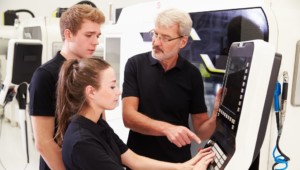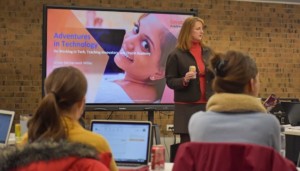Executives & Academics Partner to Advance STEM Education & Careers

By Tom Vander Ark and Sarah Cargill
Most secondary students are bored and there aren’t enough STEM graduates from college. These problems are related.
The Business-Higher Education Forum (BHEF), a network of executives and college presidents advancing innovation solutions to education and workforce challenges in the U.S., is ahead of the curve. It’s focused its programming on ramping up efforts in deeper learning and STEM education.
“We’re looking to create synergies between these two streams of work,” said Steve Barkanic. “We believe deeper learning is under the umbrella of college readiness.” We talked to Barkanic, a former HHMI and Gates Foundation officer, at a Hewlett Foundation meeting focused on deeper learning.
Barkanic stressed that the demand for competent and highly skilled workers in STEM careers is high, “but the ability of our educational system to currently deliver students of this caliber is low.” BHEF’s bet is that partnerships and pilot programs involving corporations and higher education can move the needle on developing a new generation of STEM students.
In its first regional workforce development initiative, BHEF helped the University System of Maryland to develop a program to prepare “cyber-enabled professionals.” The Advanced Cybersecurity Experience for Students (ACES) was announced in June and sponsored by Northrop Grumman Corporation. A $1.1 million grant will help to create a residential honors program focused around cyber security skill development. In an incredibly selective and competitive program, it offers students quality courses rich with extracurricular activities, speakers, mentors, and work experience.
BHEF is also backing a project at City University of New York around sustainable cities in partnership with IBM to create new student pathways in energy sustainability and large-data analytics. “It’s an exciting opportunity to use a living environment as a laboratory,” said Barkanic. “Too often we hear or see that internships – of the substantive kind – are reserved for higher-level students. We’re trying to drive those earlier on because they’re really instrumental in showing the application of what students are learning in the real world.”
Barkanic noted that about half of students drop out of science, technology, engineering, and mathematics (STEM) educational tracks as those who go on to graduate and enter STEM careers. He believes that partnerships that get “students out of classrooms into real world experiences” can change the equation.
“Higher education has a limited capacity in offering those opportunities,” added Barkanic. “We think industries should step up and offer those opportunities through internships, mentoring, et cetera.”
BHEF’s efforts in STEM are a “multi-pronged strategy to address workforce and educational deficits,” said Barkanic. BHEF work is helping to make postsecondary science more engaging and applied and that should translate into more STEM grads.
This blog first appeared on EdWeek.





0 Comments
Leave a Comment
Your email address will not be published. All fields are required.